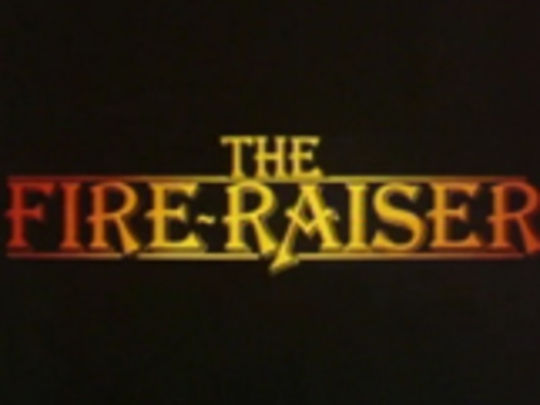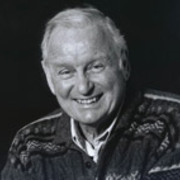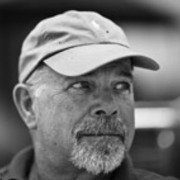
The Fire-Raiser
Television, 1986
This series has two backgrounds:
Filming The Fire-Raiser - Broken Bones and Swimming Holes
I directed two series written by Maurice Gee and produced by Ginette McDonald for TVNZ: The Fire-Raiser, and The Champion. Both were a delight to work on.
During the mid 1980s, I had spent a couple of years in Wellington at Avalon Studios, in the TVNZ drama department. Also there was Ginette McDonald, working as a director and producer. Along with the rest of the country, I knew Ginette as Lynn of Tawa, and had cast her in South Pacific Television’s production of Colour Scheme, an episode of Ngaio Marsh Theatre. Not only was she great company, but she always had a clear vision of what was required to make a programme work. When the opportunity came up to join her on The Fire-Raiser, I leapt at it. Maurice Gee was already attached as writer and was someone I admired, not only through his published works, but through working with him on Mortimer’s Patch.

Ginette McDonald on the set of The Champion (1989), her second collaboration with director Peter Sharp.
It is a measure of Ginette’s dedication, and enthusiasm, that our first production meeting was the day after she came out of hospital following her daughter's birth. A problem identified at that first meeting was that the show's initiating event involves Clippy Hedges, the local headmaster, taking the school for a swim in a river on the Marwick property. As was usual in those days, the girls swam in their 'small clothes', and the boys, suitably separated, were allowed to swim naked. Edgar Marwick, enraged by their presence, steals the boy’s clothes. Clippy, angered by this high-handed move, marches on the homestead with the naked boys in tow and, in a swirl of bare bodies, embarrasses the Marwicks, Edgar and his mother, into returning the clothes.
Filming a class of naked boys within the bounds of decency was not going to be easy, and we approached Maurice to see if he could come up with an alternative. Things went oddly silent. Maurice was usually very quick with amendments, and when the answer came back, it was that he couldn’t think of an alternative. He felt it was important that it was the Marwicks who were at fault, and that Clippy and the boys shouldn’t descend to threats to get their clothes back. So the nakedness remained. It was decided that Phil and Noel, our lead boys, could keep their knickers on as they had too much scripted action and dialogue for us to manage with nothing wider than 'cowboys', or over their shoulder shots. It was also possible that finding two boys who could act and agree to appear naked might be limiting the field too much.

Casting Phil did become a problem; nobody felt quite right, and Ginette developed a mantra that went "what we need is a young Geoff Murphy". Oft heard after another audition session, or another enquiry from wardrobe were the words "who’s playing Phil Miller?" The answer in the end was a young Geoff Murphy — his son Miles. And he was a great fit.
Casting Jon Trimmer as Edgar Marwick was another bold thought from Ginette. I’d worked with Jon as a lead with the Royal NZ Ballet, most notably in a production of Pineapple Poll where he danced the role of the blimpish Captain Belaye. There was little of Belaye in Edgar, but Jon was also a dab hand in darker roles — like von Rothbart in Swan Lake, or Koschei the Immortal in The Firebird. There seemed every chance he could infuse Marwick with the required looming menace. And so it was.
Edgar was a man of few words, which proved to be a lucky thing. The relationship between Clippy and Edgar ended in a fist fight. For reasons now lost in the mists of time, I’d decided to open the sequence with a big wide shot: Clippy and Edgar alone in a paddock, and the camera and crew a paddock away, communicating by loudspeaker. Peter Hayden (as Clippy) and Jon were thoroughly prepared for the bout, and made an impressive showing in rehearsal, and were even better after "“Action!" — until Peter delivered the final haymaker.
Jon sank to the ground, stretched out motionless as per the script. But the blow had been accompanied by a dreadful 'thwack', audible a full paddock away. Were we watching acting or real life? Peter’s reaction gave the show away; it was an emergency. There was a race across the fields to an apologetic Peter, and a bravely protesting Jon: "I’m fine, I’m fine." And so he seemed — so well that we continued shooting — and completed the scene. By then, however, Ginette had noted that Jon was looking very much less than crisp, and insisted he be taken off to A&E for a check-up.
The answer was not what we were after: a broken jaw that would have to be wired shut for the next six weeks. A disaster scenario — too much of the character was already in the can to contemplate recasting, and six weeks was too long to consider taking a break. We did reorganise the schedule to give Jon a couple of weeks off, which saw the return of some modest jaw movement. But salvation came in a number of ways.
In fire-raiser mode, he wore a mask — no problem. The brevity, and scarcity, of his dialogue meant it wasn’t too odd to cut to another character when he spoke. The final saving grace: the gothic darkness of the Marwick house interiors, with gloom relieved by the occasional slash of summer sun, meant it wasn’t too difficult to arrange for an impenetrable shadow to fall across his lips when he spoke. In post-production, Jon had to add the mysteries of post-synching to his considerable store of professional talents. In the end no one seemed to notice the agonies we’d been through.

The day eventually arrived when we had to face the decision to keep the nakedness, the swimming hole scene and aftermath. Around 12 boys were required to go skinny-dipping on camera, and then shame the Marwicks. We went to endless trouble to find a group of boys willing to strip, with parents willing to let them. Letters of intent, copies of the script sent out, permission forms signed, and then a sunny, summer day, with a closed set on the banks of the Akatarawa River. We rehearsed everyone in bathers, but the time came for a take. The second assistant director, Lissa Gordon-Crosby, was sent off to ready the boys, while the stars went through make-up and costume, and camera and grips made final checks. Everything set.
"Just a moment". A whispered communication over the comms from Lissa. Silence. Then a shout I can still hear, echoing across the valley, "GET ‘EM OFF! NOW!". Another silence, another crackle on the comms, then a whispered “We’re ready.” There’d been a short-lived rebellion amongst the boys to keep their bathers on.
There was no such hesitation when it came to the scene at the Marwicks, though it was a much more difficult shoot. The boys charging off to the river was largely covered with a wide shot from behind, as it were. Once in the concealing depths of the swimming hole, there was no problem. The scene where they discover their clothes missing benefitted from careful positioning of heaps of native flora. The one outside the Marwicks, shaming them into returning the clothes, was more complex. A lot of action in an open space, with only an occasional plough and bale of hay to preserve modesty; mainly preserved via a very detailed storyboard and shot list, and a frame-by-frame check at final edit. No indecencies, though that wasn’t enough to help international distribution: a number of countries were unprepared to countenance the sequence at all.
The Fire-Raiser was gratifyingly successful — both with the audience and at that year’s infamous GOFTA Awards. The awards were largely saved in my mind by the fact that I won one, and the excellent design of the award itself, a bronze karaka branch designed by Terry Stringer. There aren’t many awards that are half as attractive. Although in keeping with the oddities of that evening, the engraver decided that the winner of Best Director was Sharp Peter.
- Peter Sharp's many directing credits include The Champion, Mortimer's Patch and Erebus: The Aftermath.

